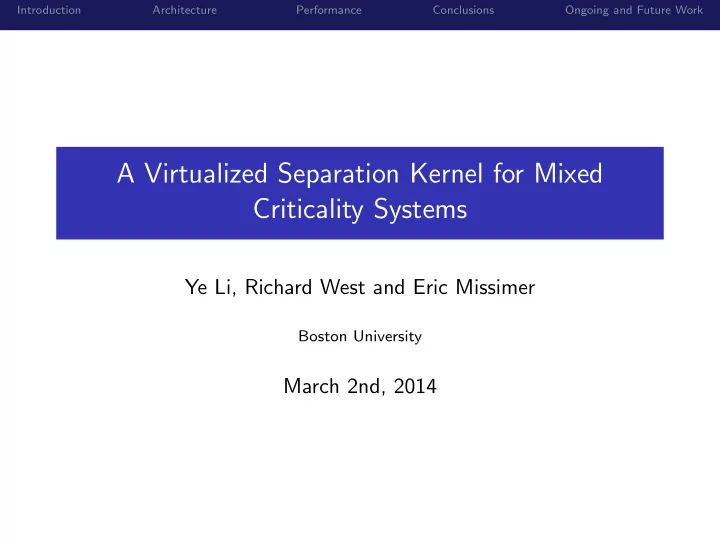

Introduction Architecture Performance Conclusions Ongoing and Future Work A Virtualized Separation Kernel for Mixed Criticality Systems Ye Li, Richard West and Eric Missimer Boston University March 2nd, 2014
Introduction Architecture Performance Conclusions Ongoing and Future Work Motivation ◮ Mixed criticality systems requires component isolation for safety and security ◮ Integrated Modular Avionics (IMA), Automobiles ◮ Multi-/many-core processors are increasingly popular in embedded systems ◮ Multi-core processors can be used to consolidate services of different criticality onto a single platform
Introduction Architecture Performance Conclusions Ongoing and Future Work Motivation ◮ Many processors now feature hardware virtualization ◮ ARM Cortex A15, Intel VT-x, AMD-V ◮ Hardware virtualization provides opportunity to efficiently partition resources amongst guest VMs H/W Virtualization + Resource Partitioning = Platform for Mixed Criticality Systems
Introduction Architecture Performance Conclusions Ongoing and Future Work Related Work Existing virtualized solutions for resource partitioning ◮ Wind River Hypervisor, XtratuM, PikeOS ◮ Xen, PDOM, LPAR Traditional Virtual Machine approaches too expensive ◮ Require traps to VMM (a.k.a. hypervisor) to multiplex and manage machine resources for multiple guests ◮ e.g., 1500 clock cycles VM-Enter/Exit on Xeon E5506 We want to eliminates hypervisor intervention during normal virtual machine operations
Introduction Architecture Performance Conclusions Ongoing and Future Work Contribution Quest-V Separation Kernel ◮ Uses H/W virtualization to partition resources amongst services of different criticalities ◮ Each partition, or sandbox , manages its own CPU, memory, and I/O resources without hypervisor intervention ◮ Hypervisor only needed for bootstrapping system + managing communication channels between sandboxes
Introduction Architecture Performance Conclusions Ongoing and Future Work Overview
Introduction Architecture Performance Conclusions Ongoing and Future Work Memory Partitioning ◮ Guest kernel page tables for GVA-to-GPA translation ◮ EPTs (a.k.a. shadow page tables) for GPA-to-HPA translation ◮ EPTs modifiable only by monitors ◮ Intel VT-x: 1GB address spaces require 12KB EPTs with 2MB superpaging
Introduction Architecture Performance Conclusions Ongoing and Future Work Memory Partitioning
Introduction Architecture Performance Conclusions Ongoing and Future Work Quest-V Linux Memory Layout
Introduction Architecture Performance Conclusions Ongoing and Future Work I/O Partitioning ◮ I/O devices statically partitioned ◮ Device interrupts directed to each sandbox ◮ Eliminates monitor from control path ◮ I/O APIC redirection tables protected by EPT ◮ EPTs prevent illegal access to memory mapped I/O registers ◮ Port-addressed I/O registers protected by bitmap in VMCS ◮ Monitor maintains PCI device ”blacklist” for each sandbox ◮ (Bus No., Device No., Function No.) of restricted PCI devices
Introduction Architecture Performance Conclusions Ongoing and Future Work I/O Partitioning PCI devices in blacklist hidden from guest during enumeration ◮ Data Port: 0 xCFC Address Port: 0 xCF 8
Introduction Architecture Performance Conclusions Ongoing and Future Work CPU Partitioning ◮ Scheduling local to each sandbox ◮ Avoids monitor intervention ◮ Partitioned rather than global ◮ Native Quest kernel uses VCPU real-time scheduling framework (RTAS ’11)
Introduction Architecture Performance Conclusions Ongoing and Future Work Linux Front End ◮ Most likely serving low criticality legacy services ◮ Based on Puppy Linux 3.8.0 ◮ Runs entirely out of RAM including root filesystem ◮ Low-cost paravirtualization ◮ Less than 100 lines ◮ Restrict observable memory ◮ Adjust DMA offsets ◮ Grant access to VGA framebuffer + GPU ◮ Quest native SBs tunnel terminal I/O to Linux via shared memory using special drivers
Introduction Architecture Performance Conclusions Ongoing and Future Work Quest-V Linux Screenshot
Introduction Architecture Performance Conclusions Ongoing and Future Work Quest-V Linux Screenshot
Introduction Architecture Performance Conclusions Ongoing and Future Work Monitor Intervention During normal operation, we observed only one monitor trap every 3 to 5 minutes caused by c puid. No I/O Partitioning I/O Partitioning (Block COM and NIC) Exception 0 9785 CPUID 502 497 VMCALL 2 2 I/O Inst 0 11412 EPT Violation 0 388 XSETBV 1 1 Table : Monitor Trap Count During Linux Sandbox Initialization
Introduction Architecture Performance Conclusions Ongoing and Future Work Quest-V Performance Overhead ◮ Measured time to play back 1080P MPEG2 video from the x264 HD video benchmark ◮ Intel Core i5-2500K HD3000 Graphics VC (VO=NULL) VO 35 VC 30 Time (second) 25 20 15 10 5 0 Linux Quest Linux Quest Linux 4SB
Introduction Architecture Performance Conclusions Ongoing and Future Work Memory Virtualization Cost ◮ Example Data TLB overheads ◮ Intel Core i5-2500K 4-core, shared 2nd-level TLB (4KB pages, 512 entries) 300000 Quest-V VM Exit Quest-V TLB Flush 250000 Quest TLB Flush Quest-V Base Time (CPU Cycles) Quest Base 200000 150000 100000 50000 0 0 100 200 300 400 500 600 700 800 Number of Pages
Introduction Architecture Performance Conclusions Ongoing and Future Work Conclusions ◮ Quest-V separation kernel built from scratch ◮ Distributed system on a chip ◮ Uses (optional) hardware virtualization to partition resources into sandboxes ◮ Protected communication channels between sandboxes ◮ Sandboxes can have different criticalities ◮ Native Quest sandbox for critical services ◮ Linux front-end for less critical legacy services ◮ Sandboxes responsible for local resource management ◮ Avoids monitor involvement
Introduction Architecture Performance Conclusions Ongoing and Future Work Ongoing and Future Work ◮ Online fault detection and recovery ◮ Technologies for secure monitors ◮ e.g., Intel TXT, Intel VT-d ◮ Micro-architectural Resource Partitioning ◮ e.g., shared caches, memory bus
Introduction Architecture Performance Conclusions Ongoing and Future Work Thank You! For more details, preliminary results, Quest-V source code and forum discussions. Please visit: www.questos.org
Recommend
More recommend